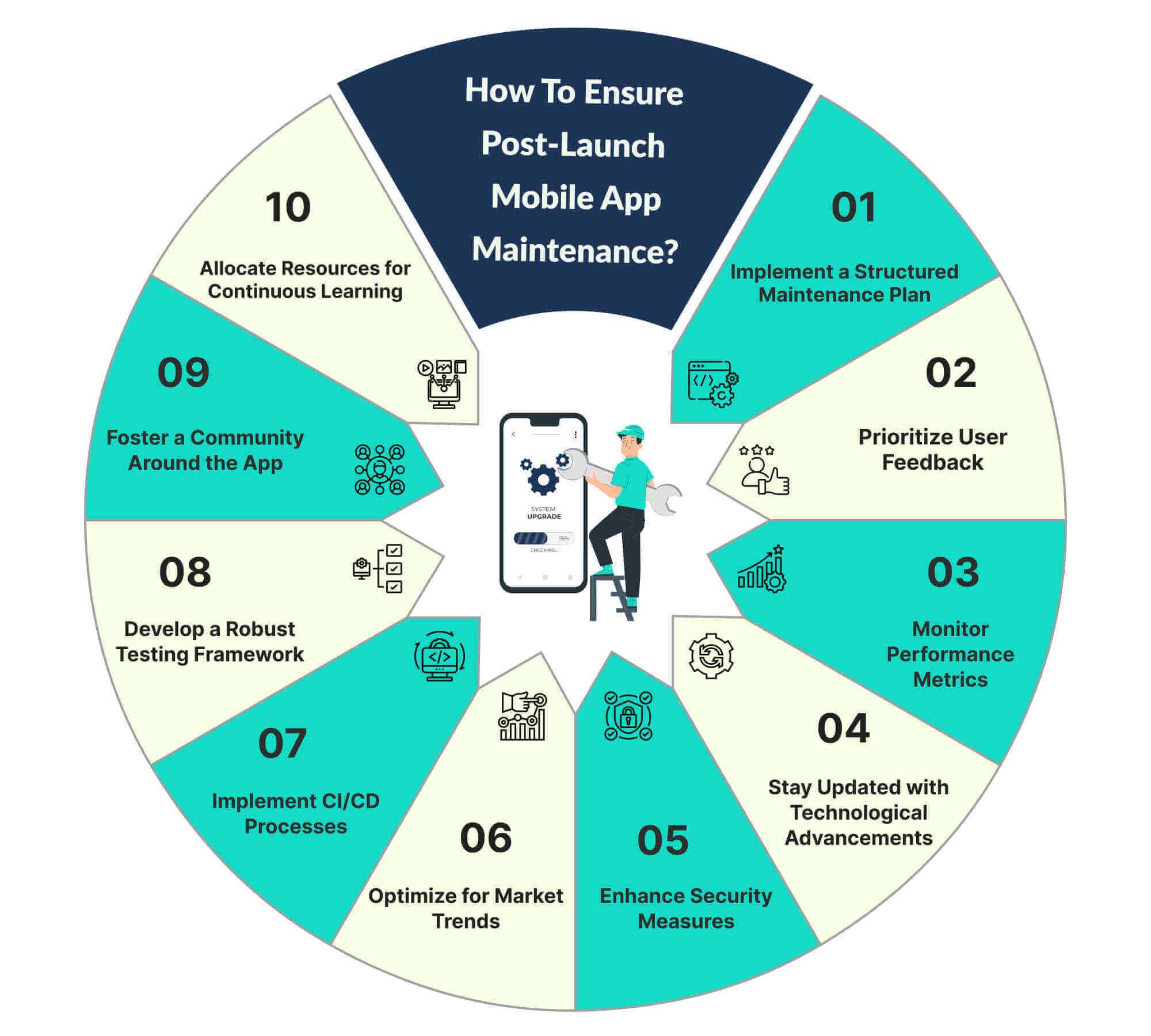The world is on a journey of digital innovation. Launching a mobile application is a significant step for an app development company. Yet, the launch of the app is only the beginning of a journey. This journey demands continuous evolution and adaptation of the mobile app. The post-launch phase is crucial for the survival and success of the mobile app. It encompasses a wide array of activities. The most important one is mobile app maintenance. These activities ensure the application remains functional, relevant, and competitive. They are necessary in an ever-changing technological landscape.
Understanding Post-Launch Maintenance
After a mobile app goes live, there’s an important step called post-launch maintenance. This step is all about making the app better, fixing it, and changing it to fit what users need now and later. It’s a key part because it deals with a few things.
First off, the app development company takes care of bugs and problems that were missed before the app was released. Next, it uses feedback from people using the app to make it better. Then, it keeps up with new tech changes. It also makes sure the app works well with the newest phones and operating systems. This part helps the app stay fresh. And it lets the app change and meet the needs of its users and the online world.
The Significance of Regular Updates
The online world keeps changing. New tech, what users like, and competition are always popping up. Keeping an app updated helps it stay fresh. Updates add new things, make it work better, and make it faster. They prove that the app development company really cares about making it great. This helps keep users happy and loyal. But updates aren’t just for fixing errors. They’re a chance to be creative and try new things.
-
Enhancing User Experience
A mobile app’s success heavily relies on offering a seamless, intuitive, and engaging user experience. Post-launch maintenance by an app development company plays a crucial role in this aspect. It focuses on optimizing the app’s interface and improving navigation. Additionally, it ensures high performance. The process involves regularly evaluating user interactions. It identifies pain points. It makes adjustments to ensure the app remains easy, enjoyable, and efficient to use. User expectations continue to rise. Thus, maintaining a high-quality user experience is crucial. The app’s usability directly impacts its retention rates and overall success.
-
Securing User Data
Data breaches and cyber threats are extremely common nowadays. Securing user data is paramount. Regular maintenance checks are essential for identifying vulnerabilities. A mobile app development company must implement the latest security measures. Additionally, they must ensure that their app is compliant with global data protection regulations. These efforts protect users’ sensitive information. They foster a trust-based relationship between the app and its users. Lately, users have become a lot more conscious of their digital footprint. An app’s commitment to security can significantly enhance its reputation and user base.
-
Sustaining User Engagement
The digital marketplace is saturated. Users are constantly bombarded with alternatives that promise newer or better features. An app must continually evolve to keep users engaged. It adds fresh content. Additionally, it also fixes bugs promptly. Finally, it introduces new functionalities that cater to users’ changing needs and preferences. This helps in retaining existing users. It also plays a major role in attracting new users. Regular maintenance helps the app stay relevant. And it helps the app continue to meet, if not exceed, user expectations.
-
Optimizing App Performance
An app can suffer from performance issues over time. These issues can stem from outdated code, unused features, or compatibility problems. An App development company should invest in regular updates and refreshes. Regular maintenance offers an opportunity to address these issues. It optimizes the app’s performance. It ensures it operates smoothly, loads quickly, and provides a seamless user experience. Performance optimization is critical in an environment where users need more patience for slow or unresponsive apps. It can significantly influence an app’s rating and user retention.
-
Adapting to User Feedback
User feedback is an invaluable resource. It offers direct insights into what users like, dislike, and desire in an app. Effective post-launch maintenance involves actively seeking out, analyzing, and acting on this feedback. An app development company can make necessary adjustments to features, design, and functionality. This improves the app. It also demonstrates to users that their input is valued. It helps in developing a community around the app and fosters loyalty.
-
Cost Efficiency
Regular maintenance is a cost-effective practice in the long run. An app development company neglecting maintenance can lead to accumulated issues that require extensive overhauls. This results in higher costs and potential loss of users. Regular maintenance helps avoid these pitfalls. It does so by addressing problems as they arise, In addition to that, it ensures the app remains competitive and continues to deliver value to its users.
-
Maintaining Competitive Edge
The app market is fiercely competitive. New applications are launched daily. An app development company needs to maintain a competitive edge. Hence an app must continually evolve. It incorporates the latest design trends, technological advancements, and features. This differentiates the app from its competitors. It also ensures that the app meets the high standards and expectations of today’s users. An app development company must maintain a proactive approach. It can significantly enhance an app’s appeal and longevity in the market.
How To Ensure Post-Launch Mobile App Maintenance?
To ensure optimal post-launch mobile app maintenance, a mobile app development company must adopt a comprehensive strategy. This strategy must address various aspects. These aspects include technical maintenance, user experience, and adaptability to market changes. Here is a detailed breakdown of the actions needed:
1. Implement a Structured Maintenance Plan:
An app development company must establish a detailed maintenance schedule. This app maintenance schedule must include regular updates, security checks, and bug fixes. The plan must be adaptable to unforeseen issues and technological changes. Yet, it should be structured enough to ensure regular reviews and optimizations of all app aspects.
2. Prioritize User Feedback:
Set up a system for collecting and analyzing user feedback. Use in-app feedback tools, social media, and app store reviews for this purpose. Responding to user feedback shows a commitment to user satisfaction. It can also guide improvements in app functionality and design.
3. Monitor Performance Metrics:
Use analytics tools to monitor the app’s performance. Track metrics such as load times, crash rates, and user engagement. Addressing performance issues quickly can improve the user experience significantly.
4. Stay Updated with Technological Advancements:
An app development company must keep up with the latest mobile technology developments. This includes new operating system versions, hardware advancements, and new programming languages. Compatibility with the latest devices and using new technology can enhance app functionality and user experience.
5. Enhance Security Measures:
Update the app’s security protocols regularly. Conduct vulnerability assessments to protect user data. Being proactive against cyber threats and complying with data protection laws are crucial. They maintain user trust and avoid legal issues.
6. Optimize for Market Trends:
Stay informed about the latest trends in app design and functionality. Updating the app to reflect current trends can maintain its appeal and competitiveness.
7. Implement CI/CD Processes:
Adopt Continuous Integration/Continuous Deployment pipelines. These processes make the development, testing, and deployment of updates more efficient. As a result, the app can adapt more quickly to user needs and market changes.
8. Develop a Robust Testing Framework:
Create a comprehensive testing strategy. This strategy should include automated testing, user acceptance testing, and beta testing with real users. This approach ensures updates are well-tested before release. It minimizes the risk of new bugs.
9. Foster a Community Around the App:
An app development company should also build a team around user engagement. They should engage with users through various platforms. Use social media, forums, and in-app communities for this purpose. Providing a space for feedback and interaction can build a loyal user base.
10. Allocate Resources for Continuous Learning:
Support ongoing education for the development team. Staying updated on best practices, languages, and tools enhances the team’s skills. It also improves the app’s quality.
Conclusion
In short, taking care of a mobile app after it’s launched is super important for an app development company and doesn’t stop. It’s not just about fixing errors. It is also about planning carefully how to make the app better over time. Keeping the app up-to-date, making sure users are happy, and adjusting to new technology trends are all key parts. Regular updates help keep the app important, safe, and one step ahead of other apps. This helps the app do well for a longer time. The value of keeping an app updated after launch is huge. It’s what keeps an app doing well and standing out in a busy digital world.
FAQs
It ensures functionality, enhances user experience, optimizes security, and maintains brand reputation.
Regular updates are recommended based on user feedback, market trends, and the app’s complexity.
Decreased user satisfaction, increased churn rates, reputational damage, and potential legal consequences.
By using automation tools, monitoring performance metrics, providing robust customer support, and educating users about updates.
It optimizes code, handles increased traffic effectively, and future-proofs the app architecture for growth.






